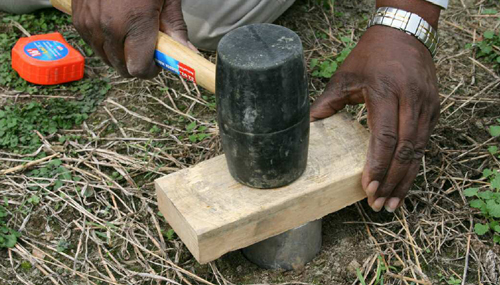Bulk Density
What it is: Bulk density is an indicator of soil compaction. It is calculated as the dry weight of soil divided by its volume. This volume includes the volume of soil particles and the volume of pores among soil particles. Bulk density is typically expressed in g/cm3.
Why it is important: Bulk density reflects the soil’s ability to function for structural support, water and solute movement, and soil aeration. Bulk densities above thresholds indicate impaired function (see table 1). Bulk density is also used to convert between weight and volume of soil. It is used to express soil physical, chemical and biological measurements on a volumetric basis for soil quality assessment and comparisons between management systems. This increases the validity of comparisons by removing error associated with differences in soil density at time of sampling.
| Table 1. General relationship of soil bulk density to root growth based on soil texture. | ||
| Soil Texture | Ideal bulk densities for plant growth (g/cm3) | Bulk densities that restrict root growth (g/cm3) |
|---|---|---|
| Sandy | < 1.60 | > 1.80 |
| Silty | < 1.40 | > 1.65 |
| Clayey | < 1.10 | > 1.47 |
Specific problems that might be caused by poor function: High bulk density is an indicator of low soil porosity and soil compaction. It may cause restrictions to root growth, and poor movement of air and water through the soil. Compaction can result in shallow plant rooting and poor plant growth, influencing crop yield and reducing vegetative cover available to protect soil from erosion. By reducing water infiltration into the soil, compaction can lead to increased runoff and erosion from sloping land or waterlogged soils in flatter areas. In general, some soil compaction to restrict water movement through the soil profile is beneficial under arid conditions, but under humid conditions compaction decreases yields.
The following practices can lead to poor bulk density:
- Consistently plowing or disking to the same depth,
- Allowing equipment traffic, especially on wet soil,
- Using a limited crop rotation without variability in root structure or rooting depth,
- Incorporating, burning, or removing crop residues,
- Overgrazing forage plants, and allowing development of livestock loafing areas and trails, and
- Using heavy equipment for building site preparation or land smoothing and leveling.
What you can do: Any practice that improves soil structure decreases bulk density; however, in some cases these improvements may only be temporary. For example, tillage at the beginning of the growing season temporarily decreases bulk density and disturbs compacted soil layers, but subsequent trips across the field by farm equipment, rainfall events, animals, and other disturbance activities can recompact soil.
On cropland, long-term solutions to bulk density and soil compaction problems revolve around decreasing soil
disturbance and increasing soil organic matter. A system that uses cover crops, crop residues, perennial sod, and/or reduced tillage results in increased soil organic matter, less disturbance and reduced bulk density. Additionally, the use of multi-crop systems involving plants with different rooting depths can help break up compacted soil layers.
To reduce the likelihood of high bulk density and compaction:
- Minimize soil disturbance and production activities when soils are wet,
- Use designated field roads or rows for equipment traffic,
- Reduce the number of trips across the area,
- Subsoil to disrupt existing compacted layers, and
- Use practices that maintain or increase soil organic matter.
Grazing systems that minimize livestock traffic and loafing, provide protected heavy use areas, and adhere to recommended minimum grazing heights reduce bulk density by preventing compaction and providing soil cover.
Conservation practices resulting in bulk density favorable to soil function include:
- Conservation Crop Rotation
- Cover Crop
- Deep Tillage
- Prescribed Grazing
- Residue and Tillage Management
For more information go to Soil Management Practices.
Measuring bulk density:
The Cylindrical Core Method is described in the Soil Quality Test Kit Guide, Section I, Chapter 4, pp. 9 - 13.
See Section II, Chapter 3, pp. 57 - 58 for interpretation of
results.

Photo: A three inch diameter ring is hammered into the soil to collect bulk density samples.
Arshad M.A., Lowery B., and Grossman B. 1996. Physical Tests for Monitoring Soil Quality. In: Doran J.W.,
Jones A.J., editors. Methods for assessing soil quality. Madison, WI. p 123-41.
